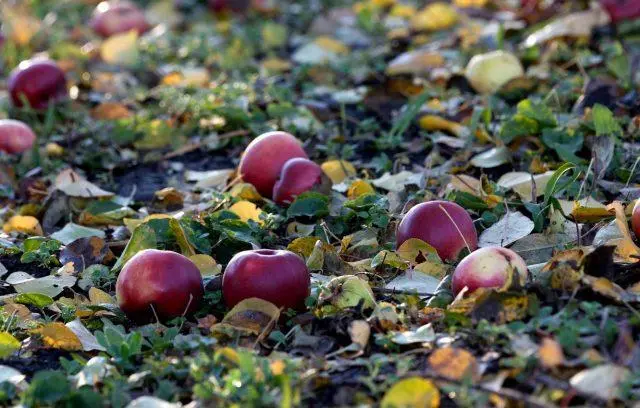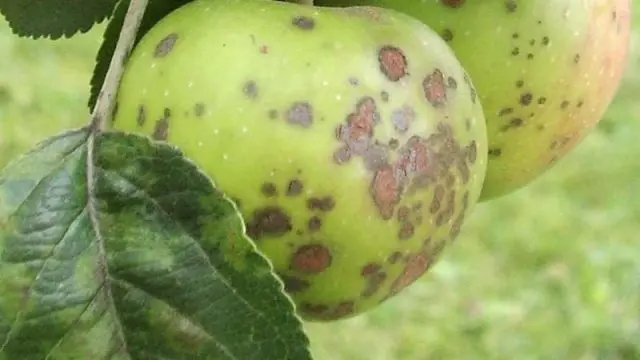Contents
You can put apples in the compost in almost any form, except when the trees are affected by insects or infectious diseases. It is impossible to lay even after treatment with drugs (at least two months must pass). The rules for preparing compost from fallen fruits and other raw materials are described in detail in the article.
Can you throw apples into a compost pit?
Fallen apples and other fruits are called carrion. They can almost always be composted as the pests gradually die off and the fruits themselves provide nutrients that are useful for fertilizing.
Can I throw fallen apples into the compost?
In order not to throw out fallen apples, they can and should be put in a compost pit. They contain organic substances that accelerate the maturation of the fertilizer mixture. At the same time, spores of fungi that may be present in apples are not preserved. Insect pests and bacteria also die over time. Therefore, you can not be afraid that apples will harm plants that will be fertilized with compost.
If there are still doubts, the raw materials can be left to ripen for 2 years – this is more than enough to kill fungal spores and other pests. In addition, scab and codling moth pathogens are guaranteed to die during this time.
Can rotten apples be added to compost?
It is widely believed among summer residents that rotten apples cannot be made into compost. It is believed that they will “infect” the rest of the raw materials, and then the soil and plants. In fact, decay is a natural process carried out by bacteria. And composting is also rotting.
Therefore, rotten fruits can be put into compost. If there are many healthy parts on apples, they are cut and used to make compote. The remaining (rotten) fragments are laid in a compost pit. They accelerate the processes of decay, so that ripening will go faster.

Fallen apples can and should be put in compost
But you should not use stone fruits, for example, cherries, plums and cherry plums. They decompose for a very long time – it will take at least two years to mature.
Can apple leaves be composted?
If rotten apples can be thrown into the compost, the question remains whether the leaves can be used to make fertilizer. This can also be done, since the leaves enrich the top dressing with organic matter, including nitrogen compounds, which accelerate the growth of any crop.
Along with the apple tree, it is recommended to use the leaves of other fruit varieties (plum, pear, cherry, grapes). It is allowed to use the foliage of birch, maple, poplar (preferably after grinding). Oak, on the contrary, should not be used. It contains tannins that slow down the maturation of the compost.
Which apples should not be composted?
In some cases, fallen apples cannot be composted:
- Fruits that began to rot on the tree (right on the branch).
- Fruits from trees that suffered from insects or diseases this year.
- Fruits of apple trees that were treated with chemicals less than two months ago. In this case, substances that have not had time to decompose will get into the compost – they will pollute the soil. Ideally, if this season the trees were not treated with chemicals at all.
You can determine the appearance of diseases and pests both by the fruits themselves and by other external signs. Powdery mildew symptoms are:
- white coating on shoots, inflorescences and buds;
- browning and the appearance of black dots;
- stunting;
- drying and falling leaves;
- lack of ovaries;
- fruits are covered with a characteristic mesh.

It is strictly forbidden to use apples and foliage from diseased trees.
When infected with scab, the following symptoms are noted:
- spots on the leaves are olive green, later they turn black;
- curvature of fruits, covering them with growths and cracks.
The development of rust can be identified by yellow-brown spots on the leaves and black marks. Sometimes similar formations appear on the fruits. At the same time, the bark on young branches is covered with “warts”.
Benefits of apples in compost
Apples serve as a source of organic matter, so they provide great benefits for compost:
- acceleration of decay processes;
- enrichment of the mixture with carbon, nitrogen compounds;
- a source of trace elements, including iron, manganese, boron, zinc, magnesium, sulfur and copper.
The ratio of carbon and nitrogen in apples is 25-30 to 1. This is the best option, which is suitable specifically for compost raw materials. For example, in green, freshly cut grass, the ratio is 20:1, which is close to normal. And in dry fallen leaves – 70: 1, which is too much.
How to make apple compost
To make compost from apples, you must follow the standard scheme:
- Pick a spot, dig a hole.
- Cover the bottom with straw or chips, tree bark, small branches without shoots.
- Grind the pulp of fallen fruits and put in a pile in a small layer.
- Next, lay the soil, wood ash or manure.
- Then add foliage, potatoes (peel), mowed grass (without seeds), carrots.
- Repeat the same layers, and if all the fallen fruits have already been used, you can simply lay the ground.
- As the top layer, you can use fallen leaves, mowed weeds or dry straw.
Fertilizer ripens within 8-12 months, sometimes up to three years. If it is planned to use it for the next season, apples, after chopping, must be sprinkled with soda in the amount of 100 g per 10 kg of raw materials. Otherwise, they will greatly reduce the pH, i.e. increase soil acidity.
But if the fertilizer is planned to be left to ripen for two years or more, it is not necessary to carry out preliminary preparation. During this time, the acids will finally decompose, and the balance will be completely restored.

In bags, compost matures in 2-3 months
Compost fertilizer can be prepared fairly quickly. In this case, take a garbage bag and put food waste and plant remains in it:
- fruits of apples, pears;
- leaves;
- small branches;
- tree bark;
- cardboard and paper (pre-shredded);
- wood;
- food waste;
- tea, coffee (possible after brewing);
- vegetables, fruits, cereals in raw form.
All components can be mixed, add 100 g of baking soda per 10 kg of crushed apples. Then moisten from a spray bottle and fill the bag to the top, tamping a little. Tie off, leaving a gap for air access. Make a few holes and put it outside so that the sun constantly hits the bag.
After two weeks, put in the shade, for example, indoors or under a canopy. After a few weeks, the compost will be ready – it is better to let it stand for three months, but if necessary, you can use it after 30 days. Fertilizer is applied to the soil when digging, planting 8-10 kg per 1 m2.
Conclusion
You can safely put apples in compost without fear that rotten fruits will spoil the fertilizer. Along with them, it is allowed to put foliage. If the tree has recently been ill or has been treated with chemicals, you should not take apples and foliage from it.










